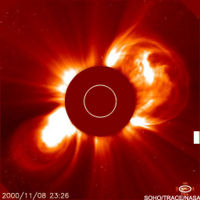Coronal Mass Ejections
Coronal Mass Ejections (CMEs) (also known as "Solar Storms") are a direct result of magnetic instabilities (i.e. solar flares) on the surface of the Sun erupting and expelling millions of tons of solar plasma into interplanetary space. CMEs are strongly influenced by the interplanetary magnetic field (IMF).
Note that most CME's are small and low energy. However, rare powerful CME's create very dangerous solar storms which require far more shielding. Space travellers and martian colonists should enter a Storm shelter for radiation protection.
See also Solar Cosmic Rays.
Contents
A hazard to settlers?
On Earth, we are protected from dangerous high energy particles emitted by the Sun. The Earth's magnetic field acts as an umbrella, deflecting incoming ions and electrons, channeling them to the Earth's poles. This generates magnificent displays of light in polar regions, the Aurora Borialis (over the North Pole) and Aurora Australis (over the South Pole). The light is emitted in the upper polar atmosphere, in the various layers of the ionosphere. Mars does not have the luxury of a protective magnetic field, and does not experience aurorae in polar regions.
In addition, the Earth's atmosphere is over 100 times thicker than Mars'. This greatly increases the insulation of the planet from solar energetic particles, magnifying the intensity of aurorae. The Earth's atmosphere has the protective thickness equivalent to 10.3 meters of water,[1] or approximately 3.4 meters of regolith (very important when considering settlement design). The protective thickness of Mars' atmosphere is equal to only about a 27 cm thickness of water.
Settlement designers must therefore assume that Mars' atmosphere will not protect settlers from high energy, ionizing particles emitted from the Sun.
However, the assumption that we must have radiations level equal to or lower than the average level on Earth is very suspect. The city of Ramsar in Iran has radiation levels 50 times higher than the typical value on Earth. The people in this city exhibit no higher rates of cancer or disease than are typical for Earth. (See Radiation for references.) It is likely that people living on Mars will simply accept higher rates of radiation.
That said, a powerful solar storm is dangerous, and if it happens during the day time, settlers will need to be in a storm shelter.
Detecting damaging CME ions
Warning Mars settlers about the onset of damaging ions is therefore a high priority. Even on Earth, predicting CMEs and dangerous ions is very important as a massive current of global scale is applied during solar storms. This effect can damage delicate satellite circuits, thermally expand the upper atmosphere (thickening the atmosphere in low Earth orbit, slowing down satellites and decreasing their orbital altitudes) and even cause damage to power grids on the ground (auroral electrojets can have the effect of overloading country-wide electricity grids).[2] Methods of predicting and detecting Coronal Mass Ejections are constantly being developed, including solar observatories, but the most effective way of detecting the onset of an Earth-bound CME is to have a probe between the Earth and Sun.[3]
A contingency for Mars
Currently, Mars has no probe or observatory in the line of sight (LOS) of the Sun, leaving an unpatrolled expanse of interplanetary space for dangerous solar ions to pass unchecked. A possible solution (akin to the Earth's SoHO[4] or ACE[5] observatories) could be to establish a simple and inexpensive solar observatory at the first Lagrangian Point[6] (L1) in the Mars-Sun system. This is a gravitationally stable point in direct LOS with the Sun where a probe can be inserted to orbit around the Sun at the same rate as Mars. This proposed system would provide some warning for Mars settlers of the propagation of solar ions toward the Red Planet. See also: Early warning system. If no such sensors were positioned between the Sun and Mars, interplanetary spacecraft or Mars habitats might be designed to include a sensor that can detect the x-ray burst that preceeds a solar proton event. However, this system would probably only provide a 20-minute advance warning.[7]
Unless the Earth and Mars have the Sun between them, warnings can be radioed from Earth as the warning times ranges from a couple hours to several hours.
However, if the sun is active with flares that could create a CME pointing in the rough direction of Mars, the explorers there should be alert to the danger. e.g. cancel long trips away from the habitat.
If the base has a radiation storm shelter, the colonists should stay in this for the couple hour solar storm, if it happens during the day time.
References
- ↑ See discussion section.
- ↑ Geomagnetic Storms Can Threaten Electric Power Grid - American Geophysical Union article.
- ↑ The Solar and Heliospheric Observatory (SoHO) acting as an early warning device.
- ↑ SoHO mission page.
- ↑ ACE mission page.
- ↑ Lagrangian Point on Wikipedia.
- ↑ Rapp D. (2006). Radiation Effects and Shielding Requirements in Human Missions to the Moon and Mars. Mars 2:46-71. https://doi.org/10.1555/mars.2006.0004
| Concepts: | Greenhouse · Settlements · Locations · General |
| Hazards: | Space Weather · Climate · General |
| Technology: | Hi-Tech · Lo-Tech · Energy · Spaceflight science · Communication · General |
| Human Considerations: | Economics · Health · Governance · Trade · Law · Social |







